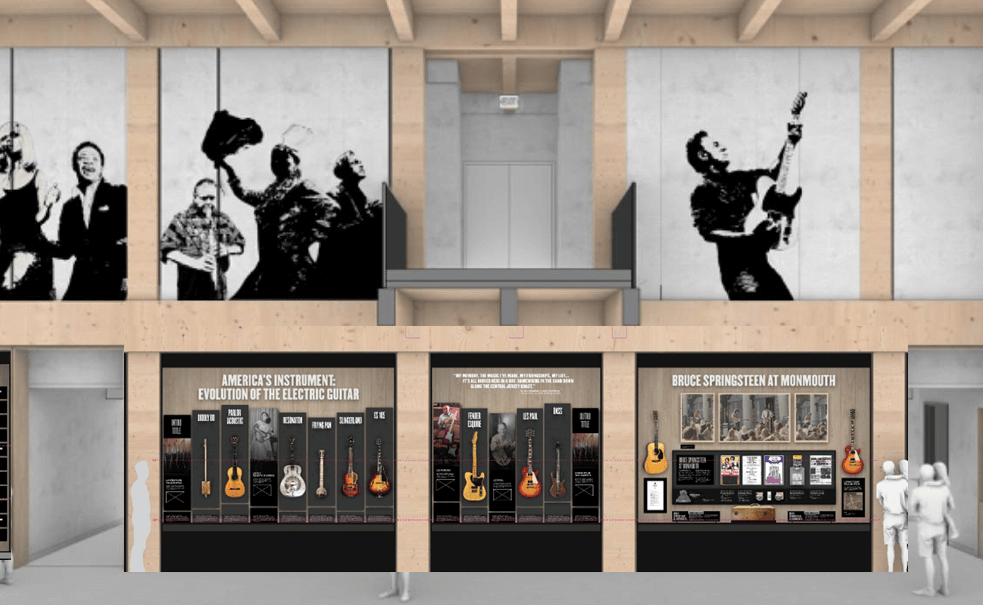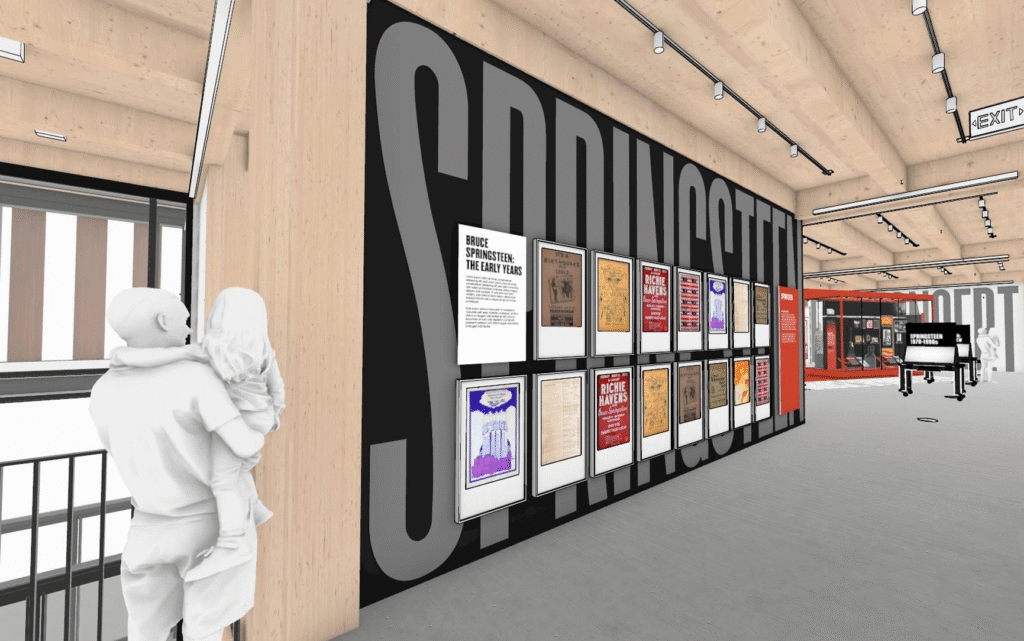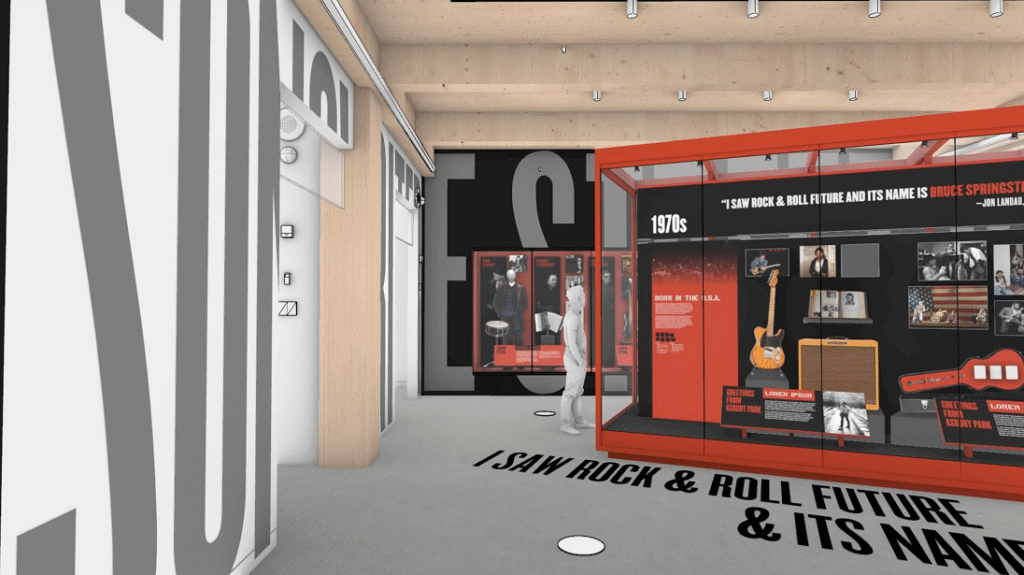“I want to say how happy I am that my archives are going to have a home here in New Jersey, that means a lot to me. Believe it or not there are people who come from around the world for their vacations or pilgrimages to spend their hard-earned dollars in Asbury Park, or Freehold in search of from whence I hailed, and now they will have someplace to go other than my house.”
– Bruce Springsteen
I recently previewed the exhibits we are curating for our new Center for our Board of Directors and then thought, “hmmm…let’s share just a tiny sneak peek with anyone who reads our blog!”
Some background, if you’re not aware: the Bruce Springsteen Archives & Center for American Music (BSACAM) at Monmouth University is currently constructing a new, state-of-the-art facility that will serve as a hub for research, education, and the celebration of American music. The 30,000-square-foot building, located at the corner of Cedar and Norwood Avenues on the Monmouth campus—not far from where Springsteen wrote Born to Run—is designed by COOKFOX Architects. Torcon is the general contractor. The environmentally conscious structure will combine steel and mass timber to create a space that is both visually striking and energy efficient. Set to open in late spring 2026, the roughly $45 million project is being funded entirely through private donations.
You can see a live feed of the construction site, here.
Inside, the building will feature a best-in-class, roughly 250-seat screening room and performance space featuring state-of-the-art DCI 4K laser projection and Dolby Atmos Feature-Certified immersive audio; an archive for research; and exhibition galleries dedicated to both Bruce Springsteen and the E Street band and the broader story of American music.
The Exhibit Design Process
I teach a Museums and Archives class here at Monmouth, and one of the first things I tell my students is this: curating an exhibit is so much more than throwing some artifacts in a case. It’s a thoughtful, multi-step process that blends research, storytelling, and design. It typically begins with developing a central theme or concept that guides the selection of objects, images, and media. Curators then conduct research to identify materials that best illustrate the narrative and consult with artists, collectors, or institutions to secure loans or permissions. Once the content is chosen, attention turns to interpretation—writing labels, wall text, and supplementary materials that engage and inform visitors. The physical or digital layout is carefully designed to shape the visitor’s experience, balancing visual impact with accessibility and flow. Throughout the process, collaboration with educators, designers, conservators, and other specialists ensures accuracy, creativity, and cohesion. Ultimately, a well-curated exhibit tells a compelling story, inviting audiences to connect with history, culture, or ideas in new and meaningful ways.
Our exhibition work is well underway. We’re collaborating with an award-winning design firm based in New York City, C&G Partners. C&G has worked with the likes of the Bill & Melinda Gates Foundation, Boston Public Library, Gallaudet University, JPMorgan Chase & Co., King Center, Library of Congress, Louis Armstrong Center, Major League Baseball, Museum of Jewish Heritage, NASA, National Archives and Records Administration, National Park Service, New York University, Peabody Essex Museum, Rockefeller University, Smithsonian Institution, U.S. Holocaust Memorial Museum, National September 11 Memorial & Museum, and New York Yankees.
The Exhibits
Now, I can’t give too much away, and, keep in mind, everything you are about to see here is still conceptual right up until it’s fabricated and installed. But when you enter the first floor of the new Center, you’ll be greeted by displays right in the lobby—that’s how keen we are to maximize the use of all available space. These lobby displays will be related to Bruce Springsteen’s decades-long relationship with Monmouth University; the evolution of “America’s instrument,” the electronic guitar; and our signature American Music Honors program.

Rendering courtesy C&G / BSACAM. Not to be duplicated without permission.
The main gallery on the first floor looks at American music history broadly, from the colonial period to the present. Rather than tell the story strictly chronologically, we will organize the displays by genre and by interdisciplinary themes such as technology, art, race, gender, and more. This, we feel, allows for more dynamic storytelling and a more accessible user experience. This gallery will also contain two interactives: a “song bar” that allows visitors to sample music from different genres and an American music map that explores how geography has influenced American music across time.

Rendering courtesy C&G / BSACAM. Not to be duplicated without permission.
The first floor of the new Center also contains a rotating gallery, which will host a new exhibit approximately every six months. Stay tuned for a future blog where we will preview the first exhibit to grace that space.
As we move to the second floor, the focus of our exhibits shifts to Bruce Springsteen and the E Street Band. A large center room will explore Bruce’s career through the decades, and honor both core members of the E Street Band and those who have joined the lineup throughout the years. There are smaller areas dedicated to Bruce’s songwriting process, a loose recreation of his writing room, a photo gallery, and immersive spaces dubbed “In Concert” and “In the Studio.” Several innovative interactives augment the instruments, costumes, and other rare archival materials featured in these spaces.

Rendering courtesy C&G / BSACAM. Not to be duplicated without permission.

Rendering courtesy C&G / BSACAM. Not to be duplicated without permission.
When it opens next year, our new Center will provide students, scholars, and fans with both access to the archives’ vast collection of materials and with thoughtfully curated exhibits, positioning Monmouth University as a leading destination for music history, scholarship, and cultural tourism.
Melissa Ziobro
Director of Curatorial Affairs
Bruce Springsteen Archives & Center for American Music
Monmouth University
October 28, 2025
